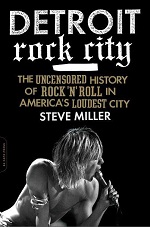Perhaps that’s one reason why this book had to be written.
Another is that it’s a Fuck You to the rest of American music.
Guitarist Al Jacquez opines that “the whole scene in Michigan was ignored on purpose”. Rolling Stone, anyone? Niagara adds: “Detroit has a deadly desert around it. Jerry Vile told me, ‘What happens in Detroit, stays in Detroit’.”
You could easily label “Detroit Rock City” as “Son of Please Kill Me” and you’d be half right. The title is a dead giveaway, It’s an oral history. Because editorial selection is alive and well, these sorts of books invariably end up dishing dirt. It’s good for sales but a few of the people mentioned within have since wished there was more focus on the music.
It’s also the sort of book that could not be published in many places other than America because the rest of the civilised world has tough libel laws.
So, there’s plenty of depravity. Arguably, not on the same level of lurid as, say, Cheetah Chrome’s autobiography or parts of “Please Kill Me” but enough, all the same.
It’s very much a narrative that’s best read when you know something about the music. Think of “Detroit Rock City” as the “colour commentary” you get when you sit down to watch your favourite sport on TV. If you know how the game unfolds, it’s hard to put this down. I read it in one-and-a-half sittings.
“Detroit Rock City” kicks off with Russ Gibb and the opening of The Grande Ballroom in 1966. It charts Detroit’s musical path on an oral timeline, underpinned by music, that you could just as easily mark with drugs d’jour. From grass and psychedelics (late ‘60s) to pills (‘70s) and smack (thereafter.)
Speaking of junk, things get street-level with Negative Approach and the Laughing Hyenas. John Brannon is still alive, isn’t he? Who knew the Birthday Party’s show in Detroit in 1983 was such a landmark moment? The birthing of a new strain of punk rock in tiny Cass Corridor clubs in the ‘80s is better documented here than anywhere else. Australia had a bit of a fixation with The Dirtbombs in the ‘90s and their story (and lingering influence in Jim Diamond as a producer) is well told.
There are gems to be dug along the way, For example, there’s former Stooges roadie and Cult Heroes singer Hiawatha Bailey’s anecdote about hoping to be a conduit for a reformation of the MC5, only to see the presence of Mike Davis and Fred Smith at his home turn into an all-in brawl with him refereeing.
The big take-out is that the Detroit of the late ‘60s and early ‘70s wasn’t just the MC5 and the Stooges. Or even Alice.
The role of Creem magazine in spreading the word is highlighted. Some things, however, inevitably fall through the cracks. The Big Two (the Five and the Stooges) get their fair share of space, as do other readily identifiable home boys like Bob Seger and Mitch Ryder, but there’s minimal space devoted to the deserving Sonic’s Rendezvous Band or their spawn. Destroy All Monsters is accorded respect, but Dark Carnival doesn’t get the time of day.
You’re given worm’s eye views of late nights at Bookie’s 870 or the Gold Dollar clubs. There’s a message there: Scenes need a focal point. If there’s any obvious pattern in the time after the so-called golden era of the Stooges and the MC5, it’s the subsequent ability of clubs to spring up and grow small but important scenes. Of course, the centre never holds and people like Bookies founding booker Scott Campbell (The Sillies), the late Bob Mulrooney (aka Bootsey X) and Ramrods singer Mark Norton all get to duke it out in print.
The various threads lead to 2000 where my interest faded (whatever happened to Jason Stollsteimer?) and thankfully so. I mean, what’s to like about techno? (Answer: Sweet Nothing.)
All, up, this is a white knuckle trawl through the dirty laundry of what was once America’s most vibrant and explosive musical heartland. Author Steve Miller has pulled some earthy insights from the mouths of his interviewees, some notoriously taciturn but universally down to earth.
As for the last word, as Rachael Nagy of the Detroit Cobras so articulately puts it: “Detroit is Detroit. It’s this beautiful place where you sacrifice your safety for a shitload of freedom.”![]()
![]()
![]()

 Call me biased and armed with far too much hindsight for my own good, but for a brief time in the late ‘60s and early ‘70s, Detroit was the lesser-known but undeniable epicentre of genuine rock and roll. The music industry, as it was, might have had its moneyed roots deeply planted on America’s East and West Coasts, but the real action was occurring deep in the US Midwest.
Call me biased and armed with far too much hindsight for my own good, but for a brief time in the late ‘60s and early ‘70s, Detroit was the lesser-known but undeniable epicentre of genuine rock and roll. The music industry, as it was, might have had its moneyed roots deeply planted on America’s East and West Coasts, but the real action was occurring deep in the US Midwest.